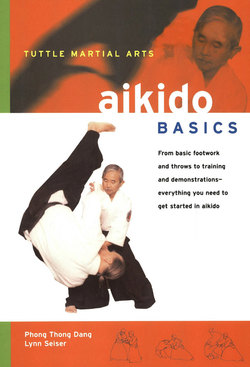Читать книгу Aikido Basics - Phong Thong Dang - Страница 8
На сайте Литреса книга снята с продажи.
ОглавлениеAIKIDOis a modern Japanese martial art that combines the traditional values of the warrior—through effective and efficient martial arts techniques—with the modern ethics of love and peace. Aikido is a nonviolent, noncompetitive martial art that offers a new model for conflict prevention, management, and resolution, as well as a means to practice personal and social responsibility.
Who Created Aikido?
Aikido was developed by Morihei Ueshiba (1883-1969), who is now affectionately called O'Sensei. His goal was to develop a martial art that would meet the needs of contemporary people. His prime concern was his love of traditional martial arts, his attempts to overcome misunderstandings about them, and his desire to reestablish their spiritual quality.
The development of aikido was Morihei Ueshiba's lifework, and he dedicated himself to the creation of aikido early in life. After watching young village hoods beat his father for his political views, he vowed to become strong enough to handle them someday. With that first vow, he began his journey into budo, the martial sciences. He studied and was influenced by many forms of martial arts, including Tenshin Shin'yo-ryu jujitsu, Shinkage-ryu swords, Yahyu-ryu jujitsu, judo, and especially Daito-ryu jujitsu.
O'Sensei Morihei Ueshiba
Morihei Ueshiba's reputation grew as he studied. This reputation attracted numerous challengers, and after he defeated many of these opponents, some became his students. On one occasion, a young naval officer came to visit the small school Morihei Ueshiba had built close to his home. O'Sensei Morihei Ueshiba attempted to explain his theories of fighting and of aiki, the concept of flowing or harmonizing with the energy of an attack rather than resisting it. But the young officer had come to challenge and fight, not to listen. Finally, Morihei Ueshiba consented to the fight. Each time the officer attacked with his wooden sword, Morihei Ueshiba easily dodged the weapon by blending with it, or moving with the line of trajectory, rather than resisting it, and was easily able to evade repeated attacks without injuring his opponent.
After a lifetime of study, he was able to unbalance and throw opponents without body contact. He was able to quickly assess his attackers' vulnerable points and defeat them. This became the basis of aikido: the ability to use an opponent's movements and energy in order to protect yourself and others.
Kisshomaru Ueshiba, second doshu
After considering many names, O'Sensei Morihei Ueshiba named his unique art aikido in 1941, after a lifetime of training in other martial arts. He studied over 200 martial arts styles in his lifetime. Aikido was his gift to humanity of blending the martial aspects of training the body with the spiritual aspects. He believed aikido to be the spirit of loving protection for all beings and the cure for a sick and violent world.
Who Carries on the Aikido Tradition?
Moriteru Ueshiba, third doshu
The leadership of aikido was passed from father to son in 1969, when the third son of O'Sensei Morihei, Kisshomaru Ueshiba (1921-1999), was named aikido doshu (leader or keeper of the way) and chairman of the Aikikai Foundation. Many attribute a more formalized training curriculum to Doshu Kisshomaru Ueshiba.
In 1999 the son of Doshu Kisshomaru Ueshiba and grandson to O'Sensei Morihei Ueshiba, Moriteru Ueshiba, became the aikido doshu after his father's death. Born in 1951, Doshu Moriteru Ueshiba graduated in 1976 from Meiji Gakuin University, became master of the Aikido World Headquarters in 1986, and in 1996 became the chairperson of the Aikikai Foundation.
Today, we can say that aikido is different from other martial arts in that its goal is to defeat opponents by unbalancing them, rather than harming them. Aikido is also different in that its modernization has not led the art into being a competitive sport with contests and tournaments, or ranks based on winning.
